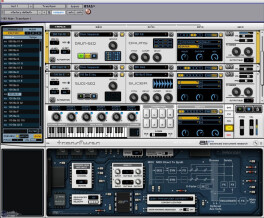A.I.R., Digidesign’s virtual instrument division, continues to provide creative tools for users of their Pro Tools software. This time, it’s a sequencer within a sequencer, dedicated to loops of all kinds and their unlimited use. Let’s take a look…
A.I.R., Digidesign’s virtual instrument division, continues to provide creative tools for users of their Pro Tools software. This time, it’s a sequencer within a sequencer, dedicated to loops of all kinds and their unlimited use. Let’s take a look…
Presentation
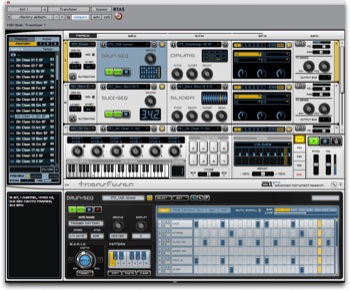 |
There’s a big box, a DVD, an activation number. Download the iLok license key, install the sound bank (requiring 1.65 GB of disk space) and RTAS plugin, nothing complicated, it’s Mac and PC compatibility, but you must (still …) have Pro Tools (LE, M-Powered or HD, from version 7) and it’s done. Then all you have to do is open the instrument in a session. Let’s take a look at its interface and how it works.
The idea is to create Tracks within Transfuser. These tracks, which bring together several modules, read audio files (according to various processes). On the left, there’s a browser pane that can be used to load Tracks (complete ensembles) or audio (separate sounds to build your own loops), whether factory or user-created. You can preview a sound by clicking on the file, preview lasts as long as you hold down the mouse, or, if Latch is enabled, for the duration of the file. A sync option synchronizes preview to the Pro Tools session tempo. There’s also a pitch and volume setting which can be adjusted as you preview. And lastly there’s a filtered search field that searches for all items in the list that match the typed-in criteria.
At the top there’s the area to which you drag and drop complete Tracks and audio files from the browser, Pro Tools region list, Pro Tools audio tracks, or the desktop (or a folder) of your computer. Either you import Tracks, in which case the modules are directly positioned, or you import audio, which opens a window offering the choice between three types of recognition/import: Sliced Audio and Slice Sequence, Time-Stretch Audio and Trigger Sequence, or Drum Kit and Drum Sequence (we’ll come back to these three types of Tracks later on). Corresponding modules will be opened in this section. Note that you can also use an external audio signal (more on this later).
Controls
 |
In the middle of the GUI are the Master and Controller sections, which have options for basic commands and settings. In the first there are six smart knobs and eight trigger pads, all assignable, a virtual keyboard (one of the octaves is dedicated to pattern switching) and a fader for crossfading between Output Busses 1 & 2. You can assign knobs via MIDI Learn, with, if necessary, definition of minimum and maximum values. The trigger pads can operate a loop, a loop segment, stop playback, etc..
 |
In the second section (the Master Section), there’s a Master Groove module that lets you work on a loop graphically or with presets (you can set a negative or positive amount of groove), access to the multi-effects master (two busses and one insert) each having four inserts with parallel or in-series routing. There’s also a handy Rec module which lets you record what’s happening inside Transfuser in real time (audio), either for importing and reworking it in the instrument itself or to export it to the Pro Tools Arrange window, the desktop, or any folder, with a simple drag and drop. Nice call!
At the bottom left there’s a contextual information pane, and to the right of that an editor pane that displays the full editor of the selected module, effect, etc. First piece of good news: Transfuser recognizes different audio formats (Wave, AIFF, Rex and Acid). But unfortunately not FCA, MP3, Apple Lossless and other compressed formats. Second piece of good news: Transformer is fairly straightforward to use (after using it a little while, at any rate), although the program is full of possibilities.
Getting Started
 |
 |
Let’s take a look at the process of importing loops. The loop, whatever it may be (bass line, drum groove, brass riff, etc.) can be used in three ways: sliced audio, time stretched audio and trigger sequence (the loop is time stretched to the PT master tempo) or cut into drum kit and drum sequences. When you open a loop, five modules appear in the dedicated section: a first module allows you to select the midi channel control, the range, and call up automation settings. The second module is a sequencer, either for slices, phrases, or drums. This sequencer will pilot a synth that will be either a Slicer, Phrase player, or a drum machine with 12 pads. Then there’s an effects processor with four inserts, that can be used in series or in parallel. Then comes the Mix section, with Mute, Solo, Volume, Pan, assignment to one of the nine output busses and send to the two multi-effects of the Master (which incorporate the principle of four simultaneous effects).
The first case, Slices. You import the waveform, you choose the first option (Slice Audio …), the file is automatically analyzed by Transfuser and all modules are put into place. You then click on Slicer, which displays the full editor at the bottom. The automatic transient detection algorithm works great and gives good results which can also be edited at will as well.
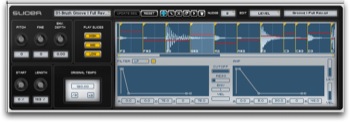 |
First you can quantize the slices. Then, via the Edit menu, you can modify the volume of individual zones with a red line. After that you can change the default assignment of each slice to the equivalent of three sub-groups (High, Mid and Low). This is interesting since you can choose to read only certain of the subgroups (all combinations are possible). This allows you to make simple changes very quickly, then save. It also has settings for pitch, envelope depth, tempo, filter, an envelope filter, and amplitude, etc.. Unfortunately, at this point, all these settings affect the file in its entirety and not slice by slice; something which is possible on good old pHATmatik Pro for example…oh well …
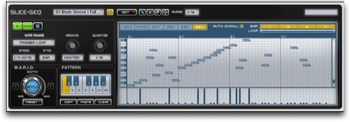 |
Sequencer Editor
 |
… Once inside the sequencer editor, things change. In fact, you can modify the order of slices, their layout (via a knob, seven presets, or basing them on the model set in the master section), finely quantize around four basic note values (from eighth-note triplets to thirty-second notes), and work on several parameters independently and/or simultaneously, and store them into one of the 12 pattern slots, which are found in the virtual keyboard of the master section.
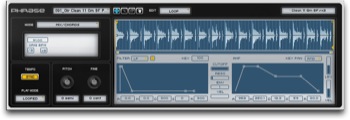 |
You can graphically edit six parameters in a dedicated lane, appearing as a piano roll editor allowing you to move things, mute notes triggering the slices (which are determined during the analysis at import), or create new ones. You can write notes on a grid of your choice (between seven note values). The six parameters are Velocity (0 to 127), Pitch, Filt (adjusting the cutoff frequency), Dec (decay), Pan and Rev. (not reverb, but reverse – reading the slice in reverse). Undo History lets you undo (of course), and a global reset is also provided. It works fine, no problems, but the edit screen is really too small, even when zoomed. It would also have been nice to be able to change tools via keyboard shortcuts or right click menus .
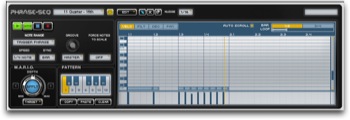 |
There’s an intriguing large button with the acronym M.A.R.I.O. The acronym stands for Musical Advanced Random Intelligent Operations. It’s said to be a musical randomization algorithm that lets you create variations of your sequence simply by clicking a single button. You choose one of six parameters, adjust the depth dial that determines the variation amount, then click Apply. A Back button lets you undo any changes. The results are quite musical, even though it will never replace things you thought out and programmed yourself. But it’s a tool that should not be overlooked, for variations or possibilities that you might not have imagined otherwise, even if you may have to rework them a little.
Tweaking Phrases
 |
Another main feature is the phrase sequencer. You import a phrase which will then be stretched to match a given tempo, or pitched to match a key, with looping or one-shot, changing the tempo in multiples of 2, etc.. Several algorithms can be applied including Drum/Perc, Lo-Fi (with granulation and Random settings), Solo/Vocals and Vocodize (with key and formant tracking), Mix/Chords and Sampler. The latter is for chordal phrases and gives the classic acceleration/change in pitch effect. You can play the original phrase, without transposition, or have it respond to a note played via Midi. Notice that the stretch and pitch algorithms work very cleanly, no doubt due to Elastic Audio (maybe even Elastic Pitch). As for phrase modifications in the piano roll editor, some features are missing and “only” Velocity, Filter, Dec and Pan are left.
AIR has provided all types of presets. So, there are of course phrases, drum sounds and other audio files, but also Midi phrases, rhythms, to load into the various sequencers, Slice, Phrase and Drums. It sounds good right off the bat! A simple guitar chord will be livened up by choosing a pattern in sixteenth notes, a drum groove comes to life instantly, and so on. Once again, nicely done!
Trigger Pads
 |
The last import mode is Drum Kit and Drum Sequence. On a drum loop, it’s pretty impressive. Transfuser analyzes the audio file, then places the different elements onto a bank of pads (2 × 12, divided chromatically on a Midi keyboard ), carefully identifying the BD, Snare, HiHat, cymbals, etc. that it assigns to the first few pads, and then constructs a sequence that corresponds (more or less depending on the complexity of the original) to the original file
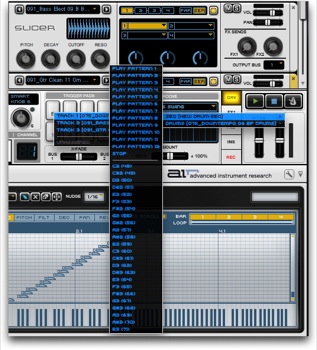 |
Each sample can then be edited individually. The first group of editing parameters are found in the waveform display window, with a choice of filter, frequency cutoff, and response to velocity and to the envelope. Next, you can adjust envelopes of pitch, volume and filtering. There’s also Solo and Mute plus an effects module (per pad!) comprising four slots …
Below that there’s pitch adjustment, cutoff, resonance, Hold and Release envelopes and their response to velocity, pan, and volume. Basically a very comprehensive, work-flow oriented, and powerful set of editing parameters. The sequence editor is also well designed, and you can also record patterns by playing them on an external controller (and not just the mouse), select independent rhythmic divisions per instrument, modify the settings of certain rhythmic divisions, create models, and automatic crescendos and decrescendos etc.. A nice feature called Simplify lets you … (yes) simplify a sequence by progressively removing elements and notes. Just assign it to a controller and you immediately have a quick way of varying patterns. Lastly, on the left, there are global settings for pitch, cutoff and decay.
So you end up with a very complete drum machine, first of all because AIR has provided an impressive number of waveforms of separate instruments and also because you can import virtually any sound source (not only drums or percussion) to get surprising results. Of course, the sequence may not be usable as is, but the distribution of the sounds onto the pads can bring new ideas. Remember that it’s also extremely easy to get sound directly from Transfuser back into Transfuser: import an audio file in Slice mode, then create another line with a New Drums, drag and drop a slice from the editor into the Drums module, which then opens, and then drop it onto one of the pads …
This is the most powerful module in Transfuser, and therefore the one that can bring your computer to its knees : 24 pads each with envelopes, four filters and effects, … it uses up resources…
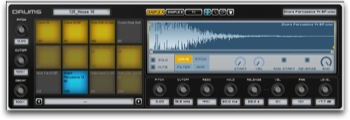 |
Automation & FX
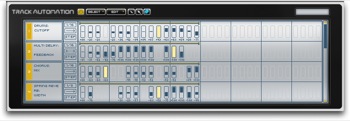 |
And finally, the icing on the cake (before going into automation and effects in detail): all patterns created in Transfuser can be used directly in Pro Tools (or elsewhere with other instruments), by performing a simple drag 'n’ drop from the Pattern to a MIDI track, Instrument, the Track List, or the Region List. Or to the desktop …
As for automation, it’s well-designed and an essential complement to the assignment of controllers and editing parameters. In fact, a few settings and knobs in Transfuser don’t have envelopes or dedicated lanes like in the various editors. But on the contrary, almost all have MIDI Learn, with assignment to an external controller or any of the internal knobs (which are assignable …). The instrument then provides 12 freely assignable automation lanes (per track). Right click on the parameter you want to automate and the menu offers the choice of lane. Then choose a quantize value (which effects reading speed, depending on the master tempo), the type of playback (one-shot or looped), and reading in Steps (abrupt changes in values) and Curve (incremental changes between two steps). Automated parameters are identifiable by a yellow LED that moves according to the values of the line.
 |
As for effects, AIR has included everything you might need and more. Each effect has a good number of settings (no simple versions here). The effects sound pretty good, have sync, have special features (such as Trigger on the Flanger which resets the LFO phase; this lets you manually start the filter sweep from that specific point in time and ensures that the filter sweep is audible). You’ll find choruses, phasers, flangers, reverbs (one of them spring), distortions, compressors (there’s Pumper that simulates a sidechain effect), enhancers, filters, Kill EQ (3-band and adjustable), Lo-Fi as well as Vinyl, Tape Delay and Multi (all very good) … Among the less common effects included is the very comprehensive Gater, offering a Pattern Editor, a multimode filter, an LFO with variable cycle length measured in steps (this is logical, but uncommon).
Or Beatcutter, a cross between Glitch, Effectrix, Major Malfunction, and Chaos Designer form Stylus RMX, though less comprehensive, but just as powerful. You can force apply effects with the corresponding force buttons of the lower row, but also use an external controller to force functions such as: Reorder, Repeat, Gate, Scratch and Freeze. Another nice idea.
And let us not forget that Transfuser has an audio input, which allows you to use all these effects to process audio by simply inserting Transfuser onto a track or a region that already has recorded audio.
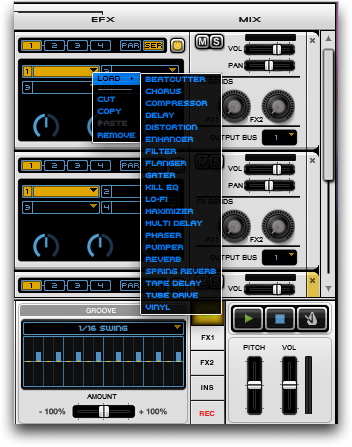 |
Conclusion
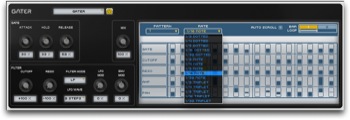 |
Though Structure, Hybrid, Velvet or Strike may do their jobs perfectly, there’s nothing revolutionary about them (sampling, synthesis, emulation of electromechanical keyboards and Drumstations). Transfuser, without being completely revolutionary, does have a real concept, and can claim to be the first totally original VSTI by AIR. It’s definitely the most complete instrument geared at loop-based music at present. The number of tracks and effects available let you do almost everything necessary solely within it. To get the most out of it nevertheless requires a certain amount of learning time. The use of external controllers is also particularly well thought out.
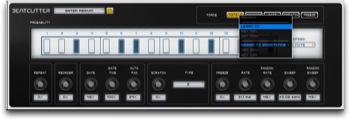 |
This opens up new horizons within Pro Tools, particularly for live settings. This may seem strange, to say the least, since Digidesign software is largely studio geared. But you can also see a pattern (or strategy) developed for live musicians and DJs that started with the Mbox Micro, both of which are also being offered in bundles.
Pro Tools on stage? Is it possible? The competition is fierce, from Live to Mainstage, Usine to Reason, Receptor to SM Pro … Digidesign’s version would really have to deliver, seeing how it’s Pro Tools exclusive. There’s no problem recognizing that Transfusion, which is extremely comprehensive and powerful (you’ll need a powerful computer for prolonged use) is up to the challenge. Especially since it’s use in the studio is equally handy for working with loops.


